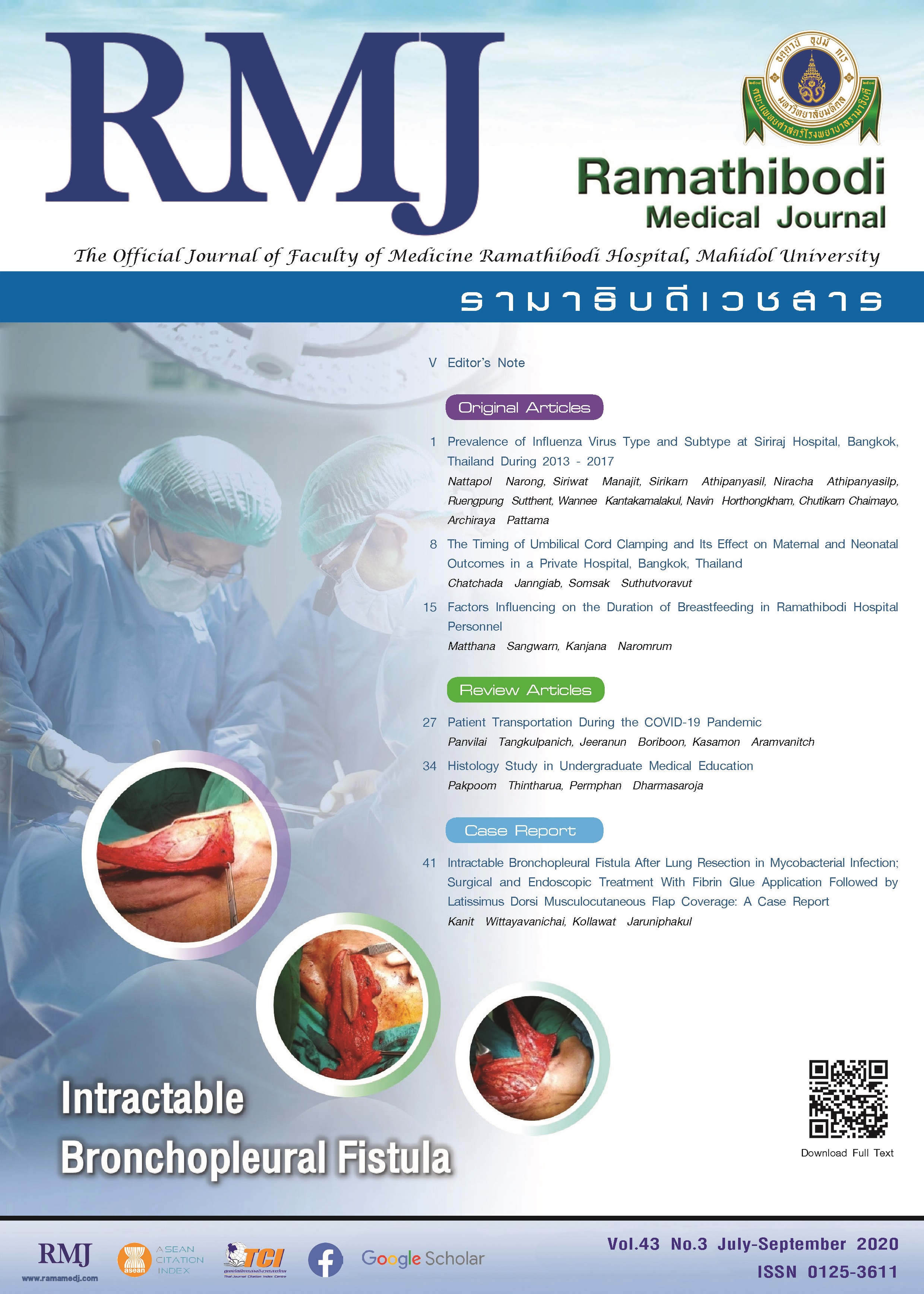Intractable Bronchopleural Fistula After Lung Resection in Mycobacterial Infection; Surgical and Endoscopic Treatment With Fibrin Glue Application Followed by Latissimus Dorsi Musculocutaneous Flap Coverage: A Case Report
DOI:
https://doi.org/10.33165/rmj.2020.43.3.240586Keywords:
Bronchopleural fistula, Mycobacterial infection, Lung surgery, Latissimus dorsi flap, Vacuum dressing, Chest wall defectAbstract
Postoperative bronchopleural fistula (BPF) is a challenging and complicated problem to cope with. Involving with multidisciplinary care team is essential for the best outcome. This report provides our experiences in intractable BPF after lung resection surgery which fail to completely heal after received surgical and endoscopic treatment. A 56-year-old female with no known underlying disease presented with nonmassive hemoptysis, productive cough, low-grade fever, and significant weight loss for 3 years. Her sputum consisted of Mycobacterium abscessus with multidrug resistant. Radiological examination revealed reticulonodular infiltration at middle lobe of the right lung and lingular lobe of the left lung, also a bronchiectatic change of both lungs. After 3 years of medical treatment, neither of her symptoms nor radiological findings improved. Therefore, a video-assisted thoracoscopic surgery (VATS) with middle lung lobectomy and lingulectomy was performed. After that, BPF at lingular stump occurred. Many surgical and endoscopic techniques followed by latissimus dorsi musculocutaneous flap along with vacuum dressing were introduced to encourage the complete healing of the BPF. One month later, the patient’s clinical was improved and endoscopic findings showed nearly complete healing of the BPF. In conclusion, surgical and endoscopic treatments combined with postoperative vacuum dressing encourage patient’s symptoms to be subsided.
References
Hollaus PH, Lax F, el-Nashef BB, Hauck HH, Lucciarini P, Pridun NS. Natural history of bronchopleural fistula after pneumonectomy: a review of 96 cases. Ann Thorac Surg. 1997;63(5):1391-1396. doi:10.1016/s0003-4975(97)00409-8.
Cusumano G, Alifano M, Lococo F. Endoscopic and surgical treatment for bronchopleural fistula after major lung resection: an enduring challenge. J Thorac Dis. 2019;11(Suppl 9):S1351-S1356. doi:10.21037/jtd.2019.03.102.
Asaad M, Van Handel A, Akhavan AA, et al. Muscle flap transposition for the management of intrathoracic fistulas. Plast Reconstr Surg. 2020. doi:10.1097/PRS.0000000000006670.
Sarkar P, Chandak T, Shah R, Talwar A. Diagnosis and management bronchopleural fistula. Indian J Chest Dis Allied Sci. 2010;52(2):97-104.
Wain JC. Management of late postpneumonectomy empyema and bronchopleural fistula. Chest Surg Clin N Am. 1996;6(3):529-541.
Baumann MH, Sahn SA. Medical management and therapy of bronchopleural fistulas in the mechanically ventilated patient. Chest. 1990;97(3):721-728. doi:10.1378/chest.97.3.721.
Mazzella A, Pardolesi A, Maisonneuve P, et al. Bronchopleural fistula after pneumonectomy: risk factors and management, focusing on open-window thoracostomy. Semin Thorac Cardiovasc Surg. 2018;30(1):104-113. doi:10.1053/j.semtcvs.2017.10.003.
Lois M, Noppen M. Bronchopleural fistulas: an overview of the problem with special focus on endoscopic management. Chest. 2005;128(6):3955-3965. doi:10.1378/chest.128.6.3955.
Leuzzi G, Facciolo F, Pastorino U, Rocco G. Methods for the postoperative management of the thoracic oncology patients: lessons from the clinic. Expert Rev Respir Med. 2015;9(6):751-767. doi:10.1586/17476348.2015.1109453.

















